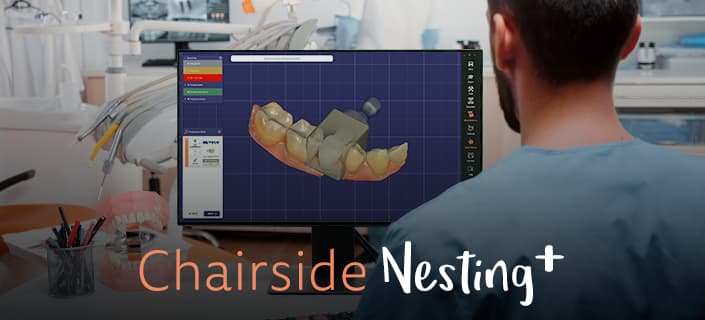1.2 Modern CAM nesting: software requirements
Dental CAD/CAM programs use digital impressions to create precise 3D models of the patient's teeth. These impressions can either be taken directly in the patient's mouth using intraoral scanners (optical impressions) or digitized indirectly from conventional impressions, models or bite impressions. Various scanning techniques, mechanical scanning procedures or other methods can be used. To facilitate the design, the programs often have libraries with prefabricated components such as implants, connecting elements, abutments and models of crowns, occlusal surfaces and bridge pontics.
In general, CAD programs occupy an important key position within the dental production chain, as they enable the representation, linking and processing of the electronic data captured. This allows the user to virtually plan and optimize the desired work with regard to various parameters. Once computer-aided design (CAD) has been completed, planning is carried out as part of computer-aided manufacturing (CAM). As this can be carried out immediately afterwards or at a great distance in terms of time and space, it is possible to integrate the same CAD and/or CAM program as so-called "OEM" software into the products of various third-party suppliers. The abbreviation "OEM" stands for "Original Equipment Manufacturer".
In principle, it is possible to design any dental work up to 100% using CAD/CAM software and manufacture it from a wide range of materials. Examples of dental work or indications include inlays, model casts, abutments, crowns, bridges, drilling templates, bars or various dental splints.
A decisive requirement is the coordination of data exchange between the interfaces of CAD/CAM programs used in dental technology. Common data formats, such as the STL format, play an important role here. The STL format is characterized by the ability to divide three-dimensional surfaces into tiny, geometric triangles that are easy to describe.
So-called "open" data formats can be used on any manufacturing machines, such as milling units or generative manufacturing devices for processing materials. (Open" data formats are a specification of digital data that can be used without any technical or legal restrictions. In contrast, "closed" systems provide company-specific, i.e. "secret" data formats. These can only be used and processed on licensed or company-owned devices.
As a particularly high level of precision is required, the appropriate CAM nesting software must be able to handle extremely large data sets. The corresponding computer and production systems must therefore have an extremely high data processing capacity and speed.
